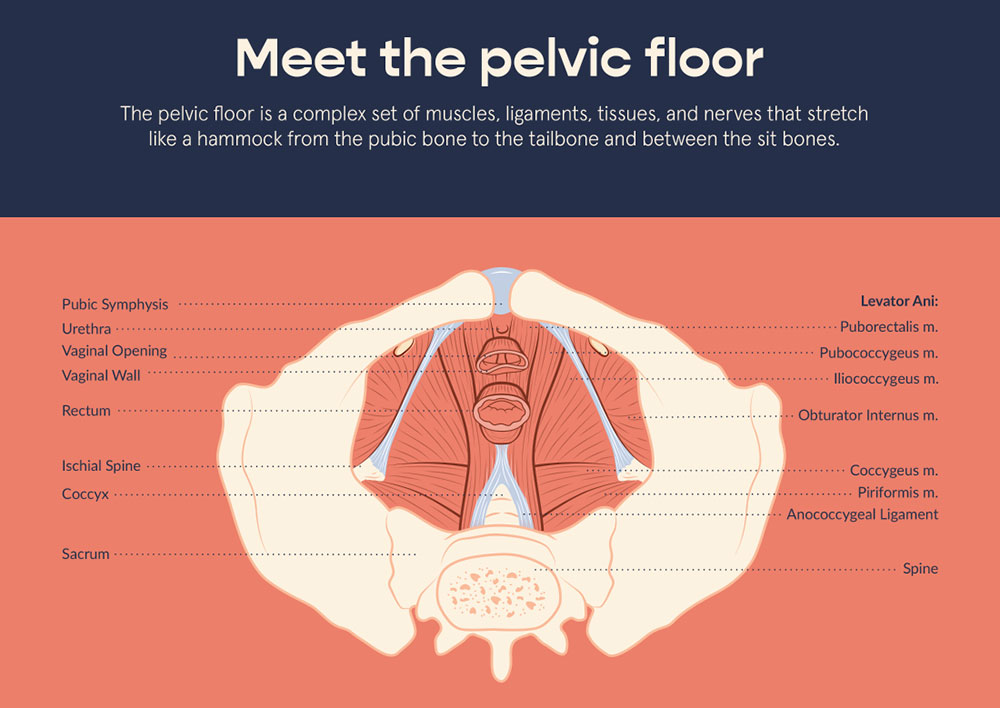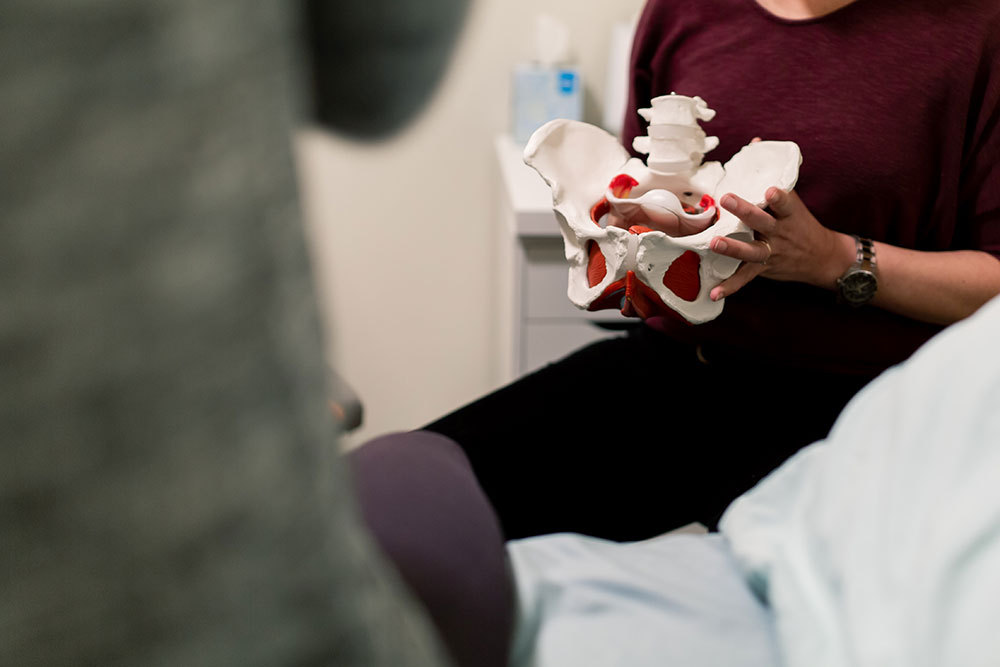6 Surprising Signs You Need Pelvic Floor Physical Therapy After Childbirth

A leaky bladder isn’t the only signal that your pelvic floor muscles could use some attention.
Carrying and delivering a baby does a number on the body. After giving birth, your hips may be wider, your breast shape different, and even your shoe size larger. Another part of the body that can be affected by pregnancy and childbirth is the pelvic floor, and although not externally apparent, its change can drastically impact daily life.
According to Origin, an online and in-person practice offering pelvic floor physical therapy, the pelvic floor is a collection of muscles, ligaments, nerves, and tissues that stretch from the pelvic bone to the tailbone and between the sit bone. “Pregnancy and childbirth can stretch, strain, and injure the pelvic floor muscles, creating dysfunction in a variety of ways,” says Ashley Rawlins, PT, DPT, a pelvic floor physical therapist in Dallas, Texas.
Pregnancy and childbirth alone are enough to weaken these muscles and possibly cause pelvic pain, but according to Celestine Compton, PT, DPT, WCS, a pelvic floor physical therapist in Los Angeles, California, it’s not always as simple as this. “What causes [pelvic floor] muscles to stop working well in the first place is different for everyone,” she explains. “Circumstances like the inability to exercise due to a high-risk pregnancy, perineal tearing during delivery, or having a urinary tract infection (UTI) can lead to pelvic floor dysfunction.”
Many of us have heard that a weak pelvic floor can lead to urinary incontinence, but Dr. Rawlins says, “The pelvic floor muscles are responsible for so much more than just controlling bladder leakage.” So, if you’re not experiencing leaking urine, how do you know if you need pelvic floor physical therapy? The body gives several sneaky signs to let you know that your pelvic floor muscles could use a little TLC.

Signs You Need Pelvic Floor Physical Therapy
Urinary Frequency
While urinary leakage is certainly a sign of a weak pelvic floor, so is urinary urgency (needing to go to the bathroom more often than usual). “Urinary frequency, which is defined as needing to empty your bladder more often than once every two hours, is often a symptom of pelvic floor muscle dysfunction,” says Dr. Rawlins. She explains that this symptom is often brushed off as “a small bladder,” but even someone with a small bladder shouldn’t experience this kind of urinary frequency. “Everyone’s bladder should be able to hold urine for at least two hours comfortably,” she stresses, “Check in with a pelvic floor physical therapist if this is not the case for you.”
Painful Intercourse
There is a lot to consider, both mentally and physically, when it comes to sex after childbirth. And while you may experience some discomfort the first time you become intimate after delivering a baby (though not everyone experiences this), it should not be an ongoing problem. “Persistent pain during sex—called dyspareunia—after childbirth is often a sign of pelvic floor muscle dysfunction,” notes Dr. Rawlins. “After childbirth, factors such as scar tissue, muscle injury, and a shift in your pelvic organ position can make sex uncomfortable—even painful—but pelvic floor physical therapy can help all of these factors and help sex feel pleasurable again.”
Constipation or Painful Passing Stool
Your urine is not the only thing that can signal an issue with your pelvic floor; your stools may also alert you. “Being able to have regular, easy, and comfortable bowel movements can be about more than just your diet and your gastrointestinal function,” explains Dr. Rawlins. “If the pelvic floor muscles are tight or have insufficient coordination, pelvic floor dysfunction could be causing your constipation,” she adds.
Weak Orgasms
No, this isn’t just a typical outcome after pregnancy and childbirth—and you don’t have to settle for mediocre orgasms because pelvic floor physical therapy can help make them stronger and more pleasurable again. Dr. Rawlins says, “Pelvic floor muscle dysfunction, which is often muscle weakness, can complicate sexual function and make orgasms feel weaker or more difficult to achieve than before childbirth.”
Tailbone Pain
Experiencing some pain after sitting? It may be a sign of a weak pelvic floor, according to Dr. Rawlins. “The pelvic floor muscles anchor on your backside at the tailbone,” she explains, “Weakness or tightness in the pelvic floor after childbirth can create instability and/or pain felt on and around the tailbone, making all sorts of activities feel painful or impossible” including sitting, bending, lifting, or even playing with your baby.
Itching or Burning Vulva
This is probably the most surprising symptom of pelvic floor dysfunction on this list. While Dr. Rawlins notes that you should always first rule out skin issues and infections that can affect your pelvic health when it comes to an itching or burning vulva, the next step may be to speak to a pelvic floor physical therapist. “Pelvic floor muscle dysfunction can irritate the nerves that provide sensation to your vulva and cause unsuspecting symptoms such as itching or burning,” she says.
Shockingly, this only scratches the surface of the long list of signs you may need pelvic floor physical therapy after childbirth. If you’re experiencing other symptoms that aren’t on this list but have you questioning your pelvic floor health, this quiz can help you determine if physical therapy is a good option.
When Should You Seek Pelvic Floor Physical Therapy?
If you’re experiencing one (or more) of these symptoms, at what point should you reach out to a pelvic floor physical therapist to address the problem? Is it ever too late to seek physical therapy to strengthen your pelvic muscles?
Dr. Rawlins and Dr. Compton agree that the sooner you seek physical therapy, the better. “I encourage people to meet with a pelvic floor physical therapist during their pregnancy, or, better yet, before becoming pregnant in the first place,” says Dr. Compton. “The more you understand your pelvic floor now, the better prepared you will be to build strength and maintain the function of your pelvic floor muscles throughout every stage of life, including pregnancy and postpartum.”
If you’re able to get to pelvic floor physical therapy proactively, that’s great, but if you’re a little too preoccupied with OB-GYN appointments and planning to bring a baby home, that’s completely understandable. In that case, Dr. Rawlins says you can safely begin pelvic floor physical therapy as soon as you are discharged from the hospital (of course, if you experience any complications, you should double-check with your OB-GYN or health care provider first).
“By seeing a pelvic floor physical therapist as soon as possible after birth, they will guide you through early postpartum recovery to set a foundation of healing, help you safely rebuild strength and confidence in your body postpartum, and provide the education you never knew you needed about the changes in your body and common symptoms you may encounter if you develop pelvic floor dysfunction,” says Dr. Rawlins.
Still, the sooner you get into pelvic floor physical therapy, the better, but it’s never too late to seek treatment. “The pelvic floor is made up of muscle,” explains Dr. Compton, “That means you are always able to make changes to it; you can build strength, improve flexibility, and reestablish control of those muscles at any point in your life.” Dr. Rawlins agrees but warns that if you do wait to start treatment, “chronic symptoms may take a little longer to heal, but there is always progress that can be made.”

What To Expect In a Pelvic Floor Physical Therapy Session
Realizing you need pelvic floor physical therapy is one thing, but what happens in a session—especially a virtual session? How does it work, exactly?
At your first appointment (or your first couple, depending on how long it takes), Dr. Compton says you should expect your physical therapist to talk about your history. “They will want to know details about your whole body, your bladder, bowel, and sexual function, your day-to-day demands, your current limitations, and your goals,” she says. Dr. Rawlins adds that your physical therapist will likely also ask about your gynecologic health, “including past pregnancy (or pregnancies), birth history, and menstruation health to learn more about what could be causing your symptoms.” She says you’ll also likely have your posture, movement strategies, and general full-body strength examined.
This evaluation also often includes an assessment of your pelvic floor (though this is not always required—especially if it makes you feel uncomfortable). “A pelvic floor muscle exam is typically performed trans-vaginally to assess the muscle strength, flexibility, tension, and coordination of the pelvic floor muscles,” says Dr. Rawlins. In the case of a virtual appointment, your physical therapist will teach you how to assess your pelvic floor muscles on your own with instructions on what to look and feel for. You’ll do this self-exam between appointments and relay your findings to your provider before your next appointment.
Once you get past the evaluation, your physical therapist will develop a treatment plan, which Dr. Rawlins says can include a customized exercise program, which often includes strengthening your pelvic floor muscles as well as your core, hips, and back, and possibly manual therapy, which she says “can help improve blood flow, normalize movement patterns, increase pelvic floor flexibility, and desensitize chronic pain signals.” Other treatments may include biofeedback, pain management techniques, neuromuscular re-education, and lifestyle and behavioral strategies.
How to Prepare for Pelvic Floor Physical Therapy
Both Dr. Compton and Dr. Rawlins agree that the most important thing is simply showing up. If it would help ease your nerves to have a little more direction before your first session, they recommend:
- Be ready for some very personal questions and come into the sessions prepared to be as open and honest as possible (they’ve heard it all, so nothing is too embarrassing to share).
- Consider wearing shorts and a shirt that you can move easily around in—avoid a romper or jumpsuit because you can’t take your pants off without completely stripping down in the process.
- If virtual, give yourself plenty of space to move around so your physical therapist can easily observe your posture and joint alignment.
Also, Dr. Compton notes that there is no need to cancel your appointment if you’re on your period—again, it’s nothing they haven’t seen or worked with before.
Average Duration of Pelvic Floor Physical Therapy Treatment
No one wants to go into a treatment situation fearing that it will last forever, and thankfully, that’s not how pelvic floor physical therapy works. That said, there is no one-size-fits-all answer here because everyone is different.
“The number of sessions and frequency for which someone needs to be seen will largely depend on what you need pelvic floor physical therapy for, how complex your symptoms are, and how long you have been having symptoms,” says Dr. Rawlins.
Some things that may impact the duration of your treatment, according to Dr. Compton, include “what is causing the dysfunction, the severity of the dysfunction, how long symptoms have been going on, what your goals are, and how much space and time you can commit to your physical therapy program.”
Dr. Rawlins says, “On average, people will attend pelvic floor physical therapy once weekly for four to six months.” Keep in mind this is just an average, though, so your treatment may be shorter or longer depending on your situation. Fortunately, many insurance plans will cover pelvic floor physical therapy, so you likely won’t have to cover treatment out of pocket completely. (Origin currently accepts most major medical insurance plans in California and Texas, as well as select plans nationwide, and they are continuing to expand to make treatment more widely accessible.)
If you think you’re experiencing any of these symptoms—or something else you suspect may have to do with your pelvic floor’s wellness—Origin offers quizzes to help you determine if pelvic floor physical therapy is right for you. Currently, there are three options: a general pelvic health quiz, a quiz specific to painful sex, and a dedicated postpartum quiz. You can also schedule a free introduction call or jump ahead and book an appointment (use code 30PNMAG for $30 off* your first visit). No matter what you decide, there is accessible treatment available that will improve your quality of life.
*Discount will be applied for patients paying out-of-pocket or with out-of-network insurance coverage.








